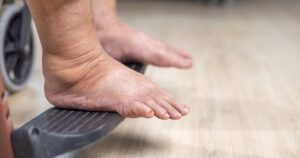Lymphedema, a condition often misunderstood, significantly impacts the elderly population. This article provides a comprehensive overview of how lymphedema affects older adults, detailing its causes, symptoms, and the unique challenges it presents. We will explore effective management strategies and special care requirements to enhance the quality of life for those affected by lymphedema.
Lymphedema in the Elderly
Lymphedema in the elderly presents unique challenges due to age-related physiological changes and comorbidities. The impact of lymphedema on quality of life can be significant, affecting mobility, independence, and overall well-being. Addressing these specific challenges requires a comprehensive and tailored approach to lymphedema treatment and care.
Unique Challenges Faced by the Elderly
Elderly individuals affected by lymphedema face a number of unique challenges. These challenges can include:
- Reduced mobility makes self-care difficult.
- Age-related skin changes that increase the risk of infections.
Comorbidities can also complicate lymphedema management, and cognitive impairments may hinder adherence to treatment protocols, requiring extra support from healthcare providers and caregivers.
Impact of Lymphedema on Quality of Life
The impact of lymphedema on the quality of life for elderly individuals is substantial. Reduced mobility and discomfort can lead to decreased independence and social isolation. The chronic nature of lymphedema may cause psychological distress, including anxiety and depression. Effective lymphedema treatment focuses on both physical and emotional well-being.
Statistics on Lymphedema in Older Adults
While precise statistics on lymphedema in older adults are limited, studies suggest a higher prevalence in this age group, especially among those with a history of cancer treatment. Breast cancer survivors are particularly affected by lymphedema, with a significant percentage experiencing arm swelling post-treatment. Further research is needed to fully understand the scope and impact of lymphedema in the elderly.
Managing Lymphedema
Practical Tips for Daily Management
Effective lymphedema management involves incorporating practical tips into daily routines. Meticulous skin care is essential to prevent infections, a common concern when the lymphatic system is compromised. Regular, gentle exercise encourages lymph drainage and helps maintain mobility. Elevating the affected limb whenever possible reduces swelling and discomfort. It is important to adopt these measures to manage lymphedema effectively.
Importance of Physical Therapy
Physical therapy plays a crucial role in managing lymphedema. Specialised exercises and manual lymphatic drainage techniques, performed by a trained therapist, stimulate lymph flow and reduce swelling. Physical therapy can also improve range of motion and prevent fibrosis, enhancing overall limb function. Regular sessions with a physical therapist are a vital component of lymphedema treatment, especially beneficial for lymphedema in the elderly.
Role of Compression Garments
Compression garments are a cornerstone of lymphedema management. These garments provide external support to the lymphatic vessels, promoting lymph drainage and preventing fluid accumulation in the affected limb. Properly fitted compression garments, whether sleeves or stockings, are essential for maintaining reduced swelling and improving comfort. Consistent use of compression garments significantly aids in treating lymphedema and can prevent progression.
Lymphedema Treatment Options
Medical Treatments for Lymphedema
Medical treatments for lymphedema focus on managing symptoms and preventing complications. While there is no cure, various therapies can effectively control swelling and improve quality of life. These may include manual lymphatic drainage, compression therapy, and in some cases, medication to manage related infections. A healthcare provider can tailor a medical treatment plan to address individual needs and manage lymphedema symptoms effectively.
Surgical Treatment Options
In certain cases, surgical treatment options may be considered for lymphedema. These procedures aim to improve lymph drainage and reduce swelling. Lymphovenous anastomosis (LVA) connects lymphatic vessels to small veins to bypass blockages. Lymph node transfer involves transplanting healthy lymph nodes to the affected area to restore lymphatic function. Lymphedema surgery is typically reserved for severe cases where conservative measures are insufficient.
Emerging Treatments and Technologies
Emerging treatments and technologies offer promising advancements in lymphedema management. Supermicrosurgery techniques, such as lymphaticovenular anastomosis, provide more precise lymphatic connections. Novel compression devices and therapies are being developed to enhance lymph drainage. Research into gene therapy and regenerative medicine holds potential for future lymphedema treatment strategies. Staying informed about these advancements is crucial for optimising patient care.
Breast Cancer and Lymphedema
Breast cancer survivors often face the risk of developing lymphedema, particularly secondary lymphedema, as cancer treatment, including cancer surgery and radiation therapy, can damage the lymphatic system. Understanding this connection is crucial for early detection and proactive lymphedema management. The development of lymphedema symptoms can significantly impact a patient’s quality of life, making awareness and early intervention essential.
Understanding the Connection
The connection between breast cancer and lymphedema arises primarily from cancer treatment methods that may disrupt the lymphatic system. Surgical removal of lymph nodes and radiation therapy can damage lymph vessels, hindering the body’s ability to effectively drain lymph fluid. This disruption may cause lymphedema symptoms, leading to swelling in the affected limb, usually the arm, and emphasising the need for careful post-treatment monitoring.
Post-Surgical Care Recommendations
Post-surgical care recommendations are vital in mitigating the risk of lymphedema following breast cancer treatment. These recommendations often include gentle exercises to promote lymphatic drainage, meticulous skin care to prevent infections, and the use of compression garments to support lymph vessels. Regular consultation with a healthcare provider is also crucial for early detection and management of any developing issues related to lymphedema.
Support Resources for Patients
Support resources play a crucial role in assisting breast cancer patients who are at risk of or are already affected by lymphedema. These resources often include support groups, specialised physical therapy services focused on lymphedema treatment, and access to certified lymphedema therapists. Educational materials and counselling services can also help patients better manage lymphedema symptoms and improve their overall quality of life.
Lymphedema Diagnosis and Treatment Centres
Accurate diagnosis is the first step in effective lymphedema management. Finding the right treatment centre is also crucial for accessing specialised care and comprehensive lymphedema treatment options. Understanding what to expect during treatment can help patients prepare and actively participate in their care plan, especially for lymphedema in the elderly.
How Lymphedema is Diagnosed
Lymphedema is diagnosed through a combination of physical examination and medical history review. Healthcare providers look for telltale signs of lymphedema, including swelling, skin changes, and discomfort in the affected limb, usually the arm or leg. Imaging techniques such as lymphoscintigraphy may be used to assess the lymphatic system’s function and confirm the diagnosis of lymphedema.
Finding the Right Treatment Centre
Finding the right treatment centre for lymphedema is essential for accessing comprehensive and specialised care. Look for a centre with certified lymphedema therapists who can provide manual lymphatic drainage and compression therapy. Consider centres that offer a range of lymphedema treatment options, including physical therapy, compression garments fitting, and surgical consultations. Ensure the centre has experience in treating lymphedema in the elderly.
What to Expect During Treatment
During lymphedema treatment, patients can expect a multifaceted approach aimed at managing swelling, improving lymphatic drainage, and preventing complications. Treatment often includes manual lymphatic drainage, where a therapist uses gentle massage techniques to stimulate lymph flow. Compression bandages or compression garments are typically prescribed to support the lymphatic vessels and reduce swelling. Regular physical therapy sessions will help maintain mobility.
In conclusion, understanding lymphedema, its causes, and its management is essential for improving the quality of life for elderly individuals affected by this condition. Early diagnosis, consistent therapy, and comprehensive care can significantly alleviate symptoms and enhance well-being. With the right knowledge and support, individuals can effectively manage lymphedema and live fulfilling lives despite this chronic condition.
Recap of Key Points
Lymphedema is a chronic condition resulting from impaired lymphatic drainage, leading to swelling, often in the arm or leg. In the elderly, secondary lymphedema is more common, often due to cancer treatment or chronic venous insufficiency. Effective lymphedema management includes meticulous skin care, physical therapy, and the use of compression garments. Early diagnosis and comprehensive lymphedema treatment are crucial for improving the quality of life.
Final Advice for Caregivers and Patients
For caregivers and patients, the key to effectively managing lymphedema lies in consistent adherence to treatment plans and proactive self-care. Ensure meticulous skin care to prevent infections and promote healing. Encourage regular, gentle exercise to support lymphatic drainage. Wear compression bandages or compression garments as prescribed, and maintain open communication with healthcare providers regarding any concerns or changes in lymphedema symptoms.
FAQs about Lymphedema Care
1. What is lymphedema in the elderly?
Lymphedema is chronic swelling caused by impaired lymphatic drainage, often affecting the arms or legs of older adults.
2. What causes lymphedema in seniors?
It can result from cancer treatments (surgery or radiation), chronic venous insufficiency, or congenital lymphatic issues.
3. What are the main symptoms of lymphedema?
Common signs include swelling, heaviness, tightness, skin changes, and recurring infections.
4. How can lymphedema be managed in the elderly?
Management includes skin care, compression garments, physical therapy, gentle exercise, and sometimes surgery.
5. Does lymphedema affect quality of life?
Yes, it can reduce mobility, independence, and emotional well-being, but proper care can significantly improve comfort and daily life.





